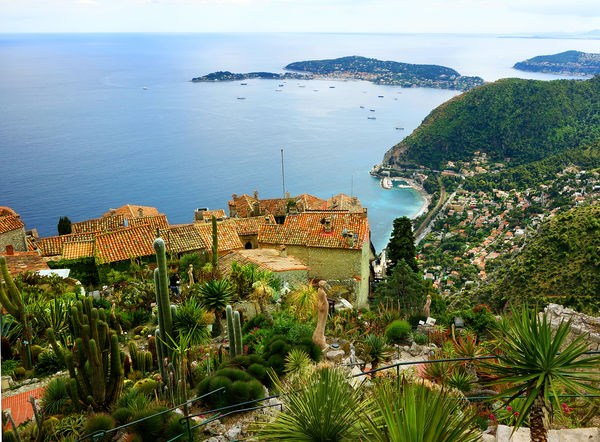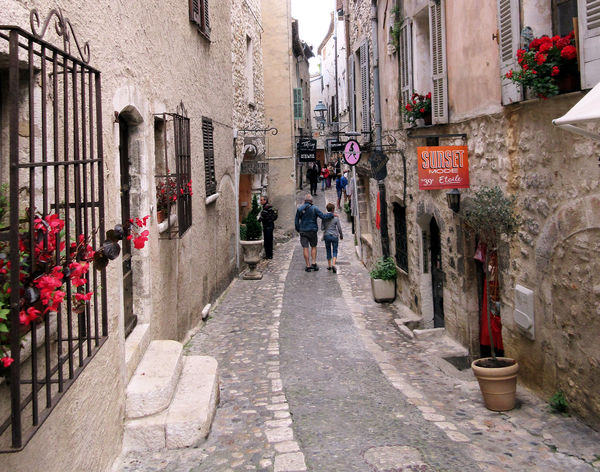The French Riviera: Beyond the Beaches
By Rick Steves

"French Riviera" — the words instantly conjure images of France's glamorous (and often packed) seaside cities and their beaches. But for some of the Riviera's best scenery — and occasional relief from the touristic crush — visit the less familiar stops in the interior.
An easy 45-minute bus ride inland from Nice, St-Paul-de-Vence is part cozy hill town and part local-artist shopping mall. It's appealingly artsy, but this famous Riviera spot is also one of the most-visited villages in France…and it feels that way. Its attraction is understandable, as every cobble and flower seems just so, and the setting is postcard-perfect. Beat the crowds by showing up here for breakfast, or come for dinner and experience the village at its tranquil best.
Meander into St-Paul's quieter streets and wander far to enjoy the panoramic views. Or consider a steep 20-minute walk uphill to the prestigious (and high-priced) Fondation Maeght gallery, with its world-class contemporary-art collection and pleasant gardens. The unusual museum building is purposely low profile to let the art take center stage. Works by Fernand Léger, Joan Miró, Alexander Calder, Georges Braque, and Marc Chagall are thoughtfully arranged in well-lit rooms.
Just a 10-minute bus ride from St-Paul, the enjoyable hill town of Vence bubbles with workaday and tourist activity. (No boutique shortage here.) Once a haunt of D. H. Lawrence, Henri Matisse, and Marc Chagall (who later settled in St-Paul), the town has a buzzing daily market and small cathedral (Notre-Dame de la Nativité) with a fine Chagall mosaic depicting a baby Moses being saved from the waters of the Nile.
Matisse fans make the pilgrimage here to see the much-raved-about Chapelle du Rosaire (Chapel of the Rosary) for its stained glass and brooding tile sketches. The chapel, a short drive or 20-minute walk from town, was designed by an elderly and ailing Matisse as thanks to the Dominican sister who had taken care of him (he was 81 when the chapel was completed). The modest chapel holds a simple series of black-on-white tile panels and uses three symbolic colors in its stained glass windows: yellow (sunlight and the light of God), green (nature), and blue (the Mediterranean sky). Matisse was the master of leaving things out. The goal here, he wrote, was "to give it, solely by the play of colors and lines, the dimensions of infinity."
Eze-le-Village, floating high above the sea, is a spectacular medieval town mixing perfume outlets, fancy boutiques, outrageously priced hotels, steep cobbled lanes, and magnificent views, making it a handy stop between Nice and Monaco. This flowery and flawless village (don't confuse it with the seafront town of Eze-Bord-de-Mer) can be packed with visitors. Touristy as it is, its stony state of preservation and magnificent hilltop setting over the Mediterranean affords a fine memory.
The Château Eza dominates Eze-le-Village. It was the winter getaway of the Swedish royal family from 1923 until 1953; today it's a hotel. The château's tearoom, on a cliff overlooking the jagged Riviera and sea, offers the most scenic coffee or beer break you'll ever enjoy — for a price. The sensational view terrace is also home to an expensive-but-excellent restaurant.
Drop in on the Fragonard or Galimard perfume outlets to watch the production process and shop the fragrant collections. Or visit the Jardin d'Eze, a prickly festival of cactus and exotic plants suspended between the sea and sky at the top of Eze-le-Village. Since 1949, the ruins of an old château have been home to hundreds of different plants 1,400 feet above the sea. Nearby hills provide ideal picnic perches…and on a clear day you can even see Corsica.
A short drive away, you can marvel at a towering propaganda monument erected by the Romans 2,000 years ago — Le Trophée des Alpes (Trophy of the Alps). The massive monument commemorates Augustus Caesar's conquest of the Alps and its 44 hostile tribes. The towering inscription (the longest such inscription surviving from ancient Roman times) tells the story: It was erected "by the senate and the people to honor the emperor." It's amazing to think that this stony structure celebrates a victory that kicked off the Pax Romana — the last of the barbarian tribes had been defeated and the greatest period of the Roman Empire could begin.
From the Trophée des Alpes, you can look down on the tiny country of Monaco and at the teeming, traffic-filled coastline of the Côte d'Azur. While tourists are struggling to find a peaceful corner of the coast, you'll be thankful that you ventured away — to enjoy some of France's most perfectly perched hill towns, evocative monuments, and splendid scenery. For your French Riviera escape, head inland and upward.

